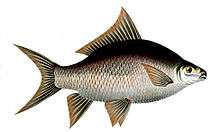Catla
| Catla | |
|---|---|
| | |
| Young catla. | |
| Scientific classification | |
| Kingdom: | Animalia |
| Phylum: | Chordata |
| Class: | Actinopterygii |
| Order: | Cypriniformes |
| Family: | Cyprinidae |
| Genus: | Catla (but see text) Valenciennes, 1844 |
| Species: | C. catla |
| Binomial name | |
| Catla catla (F. Hamilton, 1822) | |
| Synonyms | |
|
Gibelion catla | |
Catla (Catla catla), also known as the major (Indian) carp, is an economically important South Asian freshwater fish in the carp family Cyprinidae. It is commonly found in rivers and lakes in northern India, Nepal, Myanmar, Bangladesh and Pakistan. In Assam it is known as Bahu or Bhokua or Baudhekera.
Catla is a fish with large and broad head, a large protruding lower jaw and upturned mouth. It has large, greyish scales on dorsal side and whitish on belly.
Catla is a surface feeder and midwater feeder also. Adults feed on zooplankton but young ones on both zooplankton and phytoplankton. Catla attains sexual maturity at an average age of two years and an average weight of 2 kg.
Taxonomy

The catla is the only member of its monotypic genus Catla, and is listed as Catla catla for instance in FishBase. Nevertheless Catalog of Fishes indicates Gibelion as the valid (senior) name of this genus.[1]
Aquaculture
It is one of the most important aquacultured freshwater species in South Asia.[2] It is grown in polyculture ponds with other carp-like fishes, particularly with the roho labeo and mrigal carp. The reported production numbers have increased sharply during the 2000s, and were in 2012 about 2.8 million tonnes per year.[3]
Catla is sold and consumed fresh, locally and regionally. It is transported on ice. Fish of 1–2 kg weight are preferred by the consumers.[3]
References
- ↑ Eschmeyer W (2014) Cyprinus catla CAS Catalog of Fishes
- ↑ Development of freshwater fish farming and poverty alleviation - A case study from Bangladesh
- 1 2 Catla catla (Hamilton, 1822) FAO Fisheries and Aquaculture Department, Cultured Aquatic Species Information Programme
- Catla catla - http://en.bdfish.org/2010/02/catla-catla-catla-hamilton-1822/.BdFISH
- Menon, A.G.K. 1999 Check list - fresh water fishes of India. Rec. Zool. Surv. India, Misc. Publ., Occas. Pap. No. 175, 366 p.
